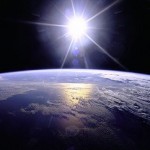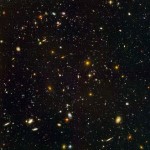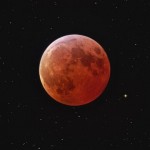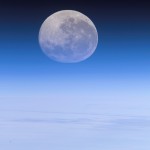Faith And Reason In The ‘Year Of Astronomy’
 Madrasahs, like this one in Bukhara, were key to developments in mathematics, astronomy, and the arts.
Madrasahs, like this one in Bukhara, were key to developments in mathematics, astronomy, and the arts.
January 17, 2009
by Jeffrey Donovan
Heaven may be religion’s business, but the heavens — the planets and stars — are astronomy’s.
Well, not quite.
Mankind’s quest for God has always pointed to the heavens. It’s no accident, then, that the path of faith led Muslim astronomers — and, later, Christian Europeans — to discover scientific truths behind the planets and the stars.
As the world marks the International Year of Astronomy, the historic links between religion and science, faith and reason, are worth nothing, says Guy Consolmagno, an acclaimed American astronomer. Of course, Consolmagno, after whom an asteroid is named, is also a Jesuit who does his research at the Vatican Observatory in the papal summer palace at Castelgandolfo, south of Rome.
“John starts the gospel, ‘In the beginning was the Word.’ Now, the word ‘word’ is actually the Greek ‘logos’ which is where we get the word ‘logic’ from,” Consolmagno tells RFE/RL. “And to the Greek philosophers of that time, that word carried such a weight because it meant reason, it meant logic. And so the Gospel is saying, at the beginning was logic, was reason, were the laws of the universe. These were with God — these were God.”
As God was worth knowing, so began the quest for scientific truth, which from the earliest days fixed its gaze on the stars.
Early Successes
Ancient Persia, India, and Greece made the world’s first astronomical breakthroughs. Ptolemy of Roman Egypt, who wrote in Greek, believed Earth was the center of the universe around which the sun, planets and stars revolved. His theory stood until the 16th century when Copernicus, a Pole, defied Roman Catholic teaching and put the sun at the center of the solar system amid a much vaster universe.
His theory was confirmed by Italian Galileo Galilei, called the “father of observational astronomy” because of improvements he made to the telescope. The Year of Astronomy, kicked off by the United Nations in Paris on January 15-16, is dedicated to the 400th anniversary of Galileo’s first discoveries in 1609, which led to his imprisonment by the Vatican for heresy.
After Galileo, the Age of Reason and science would sweep Europe, leaving the rest of the world behind. But between Ptolemy and Galileo, a gap of some 1,500 years, was the “Golden Age” of Islamic astronomy, which first transformed the art of sky gazing into a pure science of the stars.
There is also growing evidence that Islamic astronomers, whose Arabic translations were often the only surviving texts of ancient Greek works including Ptolemy’s, provided fundamental impetus to the European Renaissance and the scientific explosion that followed it.
The Koran itself invites believers to find guidance in the movement of the stars. It also insists, “the Universe is ruled by a single set of laws” — which, like the Gospel of John, seems to put logic and reason behind creation.
The first Muslim astronomers studied the heavens to develop a new Islamic calendar, based on the need for months to begin when the crescent moon first appears. Called to pray five times a day, they were also compelled to find a mathematical way to fix Mecca’s direction from any location.
From Baghdad to Samarkand, from Al-Andalus (southern Spain) to Istanbul, the list of great Islamic astronomers runs long and rich.
Among the most celebrated are Albetenius, who around the year 900 determined the solar year as being 365 days, five hours, 46 minutes and 24 seconds. Other greats include Ulugh Beg, the Turkic astronomer born in Persia who made key advances in trigonometry and star cataloguing, and in the 1400s established a school on Registan Square in Samarkand, now in Uzbekistan.
Seeking Consistency
Lebanese-born George Saliba is a historian of Islamic science at Columbia University in New York. In his latest book, “Islamic Science and the Making of the European Renaissance,” Saliba traces the links between the Islamic “Golden Age” of astronomy and the Age of Reason in Europe. In particular, he cites new evidence of Arabic science impacting the work of Copernicus.
Saliba says Muslims made astronomy into a science by focusing on empirical research and developing the mathematics to support it. That proved a huge advance, he says, on the ancient world, which saw the stars in a mythological sense — as symbols of gods and deities.
“What Islam has done, what Islamic civilization has produced, is to say that astronomy is just like any other scientific discipline: It has to be consistent in explaining the physical phenomena around us with a mathematical language,” Saliba tells RFE/RL. “Of crucial importance is the emphasis on the mathematical language, that the language should be consistent with the physics we are describing. This inner consistency of science is the single most important contribution that Islamic astronomy has made.”
But where have all the great Islamic astronomers and scientists gone?
Some historians, such as Lebanon’s Amin Maalouf, blame the decline of Islamic science since the 16th century on a lack of political freedom in the Muslim world relative to that enjoyed in Europe, even under the monarchies.
Saliba, however, says the whole world fell behind Europe, scientifically.
“The rest of the world began to look comparatively as if it went into decline,” he says. “This does not only touch Islamic civilization. It touches the Indian, it touches the Chinese, and it touches actually the whole non-European world. So trying to answer this question by finding something wrong in the Koran, or something wrong in Islam misses the point, because it is not particular to Islam. It’s a universal phenomenon that Europe began to take off and the rest of the world was left behind.”
With Galileo the poster child of the Year of Astronomy, some point to his persecution by the Catholic Church as proof that religion and science can’t co-exist. It wasn’t until 1992 that Pope John Paul II apologized and rehabilitated Galileo.
But Consolmagno says many great scientific discoveries since Galileo were by Catholic clerics. Like the Big Bang theory, which George Lemaitre, a Belgian priest, first proposed in reaction to Albert Einstein’s theory of relativity.
For the American Jesuit, trained at the Massachusetts Institute of Technology, the quest for truth is at the heart of faith and science. “Religion tells me who made the universe,” Consolmagno says. “Science tells me how he did it.”
Article Source- Radio Free Europe
Four Hundred Years Ago, Galileo’s Telescope Changed The World
August 25, 2009 by Admin
Filed under tech history
 August 25, 2009
August 25, 2009Despite the summer heat, the Senate of Venice assembled on this day in 1609 to view a remarkable scientific instrument. It was built by the well-known astronomer and philosopher from Pisa, Galileo Galilei, and could make distant objects appear closer when viewed through one end of its long pipe. It was a telescope.
Not that Galileo had invented the instrument. Credit for that is generally given to a Dutch stargazer who is almost forgotten today, Hans Lipperhay, who unveiled his basic telescope only the previous year, in 1608.
But Galileo, ever the practical perfectionist, had already improved upon the basic essentials and produced a variable-focus instrument that increased the size of the observed object by eight times.
Why he presented it first of all to the assembled Venetian senators is not clear. But perhaps the Venetians, who had business and commerce in their marrow, saw this instrument as a way to boost their glass lens industry. After all, Venice along with Florence, was the leading center for high-quality ground glass for spectacle lenses and magnifying glasses.
Certainly Galileo made money building and selling his telescope to eager customers, until his designs were overtaken in a relatively short time by more sophisticated types.
The telescope, of course, revolutionized astronomical observation and had a profound impact on overall scientific methodology, by allowing more exact mathematical calculations.
Blasphemous ‘Suncentricity’
It also brought into sharp focus the simmering dispute between those who followed the ancient belief of Greek and Egyptian proto-scientists that the Earth was the center of the universe, and that the planets revolved around it, and those who followed the Copernican theory that in fact our Earth is just one of a number of planets revolving around the sun.
Nicolaus Copernicus, the great Polish astronomer, had summarized his theories that the Earth revolved around the sun, instead of the other way around, some 60 years before Galileo intrigued the Venetian senators with his telescope.
Galileo, with his passion for exact observation and independent analysis, became ever more convinced through the use of his telescope that Copernicus was right. But it wasn’t long before this brought him into conflict with the Roman Catholic Church.
Some churchmen began attacking Galileo in 1610, arguing that God had made the Earth the center of the universe as a home for man.
By 1616, the matter had come to the official attention of the church, with the formal condemnation of “suncentricity” as “false and contrary to scripture.”
Galileo was warned to steer clear of such heresy, which he did for a number of years. But in 1632 he published a defense of his views. This landed him in front of that sinister body, the Inquisition. The Holy Office, as it preferred to be known, tried him, found him guilty of being “vehemently” suspect of heresy, and placed him under house arrest.
It also forced him to recant, which he did. Not very brave perhaps, but practical to the end, he may have thought it best to be a live astronomer than a dead ideologue.
It took the church 359 years to rehabilitate Galileo Galilei. Only in 1992 did the Vatican formally acknowledge that it had been wrong and Galileo right.
The astronomer died at his home outside Florence, still under house arrest, in 1642.
1 Corinthians 15: 40-41
 “There are also celestial bodies, and bodies terrestrial: but the glory of the celestial is one, and the glory of the terrestrial is another.
“There are also celestial bodies, and bodies terrestrial: but the glory of the celestial is one, and the glory of the terrestrial is another.
“ There is one glory of the sun, and another glory of the moon, and another glory of the stars: for one star differeth from another star in glory.”
(King James Version)
Jeremiah 31: 35-37
 “Thus saith the Lord, which giveth the sun for a light by day, and the cordinances of the moon and of the stars for a light by night, which divideth the sea when the waves thereof roar; The Lord of hosts is his name:
“Thus saith the Lord, which giveth the sun for a light by day, and the cordinances of the moon and of the stars for a light by night, which divideth the sea when the waves thereof roar; The Lord of hosts is his name:
“If those aordinances depart from before me, saith the Lord, then the seed of Israel also shall cease from being a nation before me for ever.
“Thus saith the Lord; If heaven above can be measured, and the foundations of the earth searched out beneath, I will also cast off all the seed of Israel for all that they have done, saith the Lord.
(King James Version)
“God’s Message, from the God who lights up the day with sun and brightens the night with moon and stars,
“Who whips the ocean into a billowy froth, whose name is God-of-the-Angel-Armies:
“If this ordered cosmos ever fell to pieces, fell into chaos before me” —God’s Decree—
“Then and only then might Israel fall apart and disappear as a nation before me.”
(The Message)
PSALM 147:4
 “He telleth the number of the stars; he calleth them all by their names.”
“He telleth the number of the stars; he calleth them all by their names.”
(King James Version)
Genesis 1: 16
 “And God made two great lights; the greater light to rule the day, and the lesser light to rule the night: he made the stars also.
“And God made two great lights; the greater light to rule the day, and the lesser light to rule the night: he made the stars also.
“And God set them in the afirmament of the heaven to give light upon the earth,
“And to rule over the aday and over the night, and to divide the light from the darkness: and God saw that it was good. ”
(King James Version)
“God made two big lights, the larger to take charge of Day,
“The smaller to be in charge of Night; and he made the stars.
“God placed them in the heavenly sky to light up Earth
“And oversee Day and Night, to separate light and dark.”
(The Message)
Moon beckons commercial comeback for Beagle
Houston Tx -Aug 2009, BY CRAIG COVAULT, SPACEFLIGHT NOW
Project managers for the British Beagle lander program are seeking redemption – on the moon – nearly six years after their spacecraft disappeared on Mars.
Collin Pillinger who headed the unsuccessful Beagle Mars project is in discussion with the commercial “Odyssey Moon” program to fly a backup version of Beagle’s most powerful instrument on board the Odyssey lunar lander.
 Drawing of Odyssey Moon commercial robotic lunar lander depicts spacecraft nearing lunar touchdown on thrust from lunar descent engine. Discussions are underway for use of a key British Beagle Mars lander instrument on the lunar lander. The program is attempting to win $30 million Goggle Lunar X Prize. Credit: Odyssey Moon |
When lost in December, 2003, the Beagle Mars lander was seeking organic materials that could have been evidence of past life. But the Odyssey Moon program is seeking evidence for lunar resources that could be mined by future astronauts seeking profit.
The Beagle project’s magnetic mass spectrometer is especially suited for finding such molecules, says Everett K. Gibson a NASA senior geochemist and astrobiologist at the Johnson Space Center. Gibson has led Lunar Beagle studies at JSC, where the lunar version of the spacecraft has been tested. A similar Pillinger instrument is on board a European Space Agency spacecraft headed for a landing on a comet.
Years before the Odyssey Moon program came calling, the Beagle Mars program had already converted its backup hardware into a “Lunar Beagle” configuration for a NASA study on low cost robotic lunar concepts. Those study results remain viable and theoretically could result in a NASA Lunar Beagle type mission in several years, says Gibson. Top NASA headquarters personnel disagree, however.
The Odyssey Moon commercial lander and rover are under development at MacDonald Dettwiler and Associates (MDA) in Canada using Canadian technology mated with a NASA spacecraft design already tested at the NASA Ames Research Center.
Top new U. S. personnel and hardware are also being added. Jay Honeycutt former director of the Kennedy Space Center has been hired as president of Odyssey Moon Ventures, responsible for all U.S. operations and launch programs for the lunar surface venture. He is based near Cape Canaveral.
Another major appointment to boost the project’s stature is the hiring of Alan Stern, a highly experienced manager and engineer who was previously NASA associate administrator for science. Another top official is Paul Spudis, previously chief scientist at the Lunar and Planetary Science Institute in Houston. He has just been hired as Odyssey Moon’s chief scientist.
“For a number of months we have had contact with Odyssey Moon and in early July we had “more firm” discussions,” Pillinger tells Spaceflight Now. “They are interested in our mass spectrometer, but arrangements are still tentative at this moment.”
 British Beagle instruments, including magnetic mass spectrometer being eyed by Odyssey Moon program for use in finding lunar resources, is examined by Leicester University engineers in England who helped design it. Credit: Leicester University |
The Beagle magnetic mass spectrometer has a strong capability to find and analyze volatile species like hydrogen and water ice and other molecules that would be critical for discovering and using lunar resources Gibson told Spaceflight Now.
Christopher Stott, a senior executive with Odyssey Moon has held the discussions. Stott was previously a manager with Boeing on the Delta IV and later with Lockheed Martin Space Systems where he helped lead international sales efforts.
Further discussions with Stott may be delayed a few weeks, however, because his wife, NASA astronaut Nicole Stott, is set for liftoff Aug. 25 on the space shuttle Discovery. She will be delivered to the ISS for a several month mission on board the outpost.
Odyssey Moon is one of 16 competitors in the Goggle Lunar X Prize competition that will award $30 million to the first team to fund a successful commercial robotic lunar landing. The winner must also demonstrate the ability for the mother ship or its rover to drive at least 500 meters (1,650 ft.).
The Odyssey Moon team was the first to register for the prize. From all outside appearances at least, it has already amassed a strong investor and engineering team. That includes signing an agreement with NASA for commercial use of a NASA lunar spacecraft that has already been designed and tested at the Ames Research Center.
The mission will cost about three or four times more than the prize money. But Odyssey Moon is focused not on just one flight, but an ongoing series that has lunar prospecting goals as well as science objectives.
Odyssey Moon had been planning to launch in 2011. But the company indicates that launch of the first commercial robotic lunar lander “MoonOne” (M-1) will likely slip by a year to at least mid 2012.
Use of a Minotaur V or SpaceX Falcon 9 launch vehicle fits with the mission needs, although managers decline to discuss their launcher plans. Either rocket can deliver payloads of 5-50 kg to the lunar surface or 10-200kg to various lunar orbits, Ames studies indicate.
“I am extremely pleased and excited to be working on getting us back to the Moon in a sustainable way,” says Honeycutt. “I believe the private sector has an important role to play in a permanent and affordable lunar program.”
He has over 40 years of space experience, including key engineering and simulation positions at the Johnson Space Center during Apollo, Director of the NASA Kennedy Space Center and president of Lockheed Martin Space Operations.
Honeycutt will specifically focus on the commercialization of the NASA technology like the new Ames Common Bus lander. This should enable Odyssey to develop a series of robotic landings specialized for specific tasks at different landing sites.
 Ames Research Center Hover Test Vehicle is examined by NASA engineers as it hangs above safety netting prior to flight to demonstrate software for NASA’s Modular Common Spacecraft Bus. Odyssey Moon will use this basic NASA design for its commercial lunar lander. Credit: NASA |
Odyssey’s MoonOne (M-1) lunar lander will use utilize the Ames Research Center design for a modular Common Spacecraft Bus.
Under the terms of a Reimbursable Space Act Agreement with Odyssey Moon Ventures LLC, Henderson, Nev., NASA Ames will share its small spacecraft technical l data and expertise with the company.
In return, Odyssey Moon Ventures will reimburse NASA Ames for the cost of providing the technical support and will share its technical data from its engineering tests and actual lunar missions with NASA.
“NASA is a big supporter of developing the commercial space sector, and is interested in developing small spacecraft for future lunar exploration,” says NASA Ames Research Center Director Pete Worden. By making these designs available to commercial enterprises, we hope to spark rapid development of low-cost, small spacecraft missions.”
 Diagram of Ames Modular Common Spacecraft bus shows how simple subsystems could be assembled for a small NASA or commercial lunar lander. NASA has licensed its engineering data on the system to Odyssey Moon. Credit: NASA |
NASA also will share data from the Ames Hover Test Vehicle, an engineering prototype to evaluate hardware and software systems. The Goggle Lunar X prize leaves open how each contender achieves 500 meter mobility. The Ames test vehicle, however, has demonstrated that it can not only land, but also rise off the moon and fire small thrusters to move sideways. This raises the possibility that the Odyssey lander can achieve the mobility of a rover, at least to win the $30 million prize and bragging rights that will go with it.
The Odyssey Moon venture is domiciled on the Isle of Man “to take advantage of favorable regulatory and export regimes that allow us to choose the best technologies and partners from around the world,” the company says. It is actually headquartered in the U. S. in Henderson, Nevada with offices also in Washington, D. C. as well as the Cape.
Pillinger headed the Planetary and Space Science Research Institute at England’s Open University.
After Beagle disappeared without a trace a British investigation sharply criticized the project’s management and testing but the spectrometer was not faulted.
 ESA diagram shows major elements of Beagle Mars lander that disappeared during landing in December 2003. Mass spectrometer eyed for Odyssey Moon mission is among instruments on lander’s robotic arm. The disk shaped spacecraft was supposed to land useing a parachute and airbags, then open to deploy blue solar arrays and arm with instruments. Mole device (extreme left) could auger itself under rocks. Credit: European Space Agency |
The first mission will be focused on assessing resources in dark mantle near the lunar equator. The second mission will be to the lunar South Pole and focused on a direct ground level search for water-ice.
One potential equatorial target is the moon’s Sulpicius Gallus region where analysis indicates there is extensive dark mantel. The material could produce extensive “feedstock” for the production of hydrogen and oxygen. The region is more than 100 mi. north of the Apollo 11 landing.
Another option is Rima Bode, rich in black volcanic glass and thorium. U. S. Geological Survey scientists say that it too could be a major lunar mining area in future decades. The area is near the Apollo 14 landing site.
Images taken by the Lunar Reconnaissance Orbiter are helping to narrow other potential landing sites. Odyssey Moon is also extensively involved in support of and use of 45 year old NASA/Boeing Lunar Orbiter imagery. Data from those spacecraft are being to extract major new high resolution data as part of the Lunar Orbiter Image Recovery Project.
The program’s CEO, Robert Richards, is the director of Toronto based Optech Inc. the global market leader in the development, of advanced, laser-based survey systems. He also helped found the International Space University. The chairman of the Odyssey board is Ramin Khadmen who helped found Inmarsat and was Inmarsat Chief Financial Officer.
Other personnel who have joined Odyssey Moon with past careers in the Apollo program and more near term endeavors are:
Dr. James D. Burke – JPL retired; NASA Lunar Ranger Project Manager
Mr. Charles M. Chafer – CEO, Space Services Inc.
Mr. Arthur M. Dula – Space Lawyer; Founding Director of Excalibur Almaz Limited
Dr. Louis Friedman – Founder and Executive Director, The Planetary Society
Mr. Lewis Pinault – LEGO Senior Director and General Manager, LEGO Play for Business
Dr. Jean-Luc Josset – Director of the Space Exploration Institute, Neuchatel, CH
Mr. Jon Lomberg – Artist; Chief Artist, COSMOS Television Series
Dr. Bob McDonald – Science Journalist & Author
Dr. Wendell W. Mendell – lunar scientist at the Johnson Space Center
Dr. David Miller – University of Oklahoma’s Wilkonson Chair Professor in the School of Aerospace and Mechanical Engineering specializing in the design and test of planetary rovers.
USAF Col “Coyote” Smith – Former chief of the Dream Works Advanced Concepts Office in the Pentagon’s National Security Space Office
If Odyssey Moon carries the Beagle spectrometer, the fact the first Beagle Mars spacecraft “went missing without a trace” are the kind of words that should generate a tremendous amount of “British press.” This could help scientists in the United Kingdom reclaim some luster lost upon British politicians who too often believe the words “British and space” are an oxymoron.
Psalm 19:1-2
 “The heavens declare the glory of God; and the firmament sheweth his handywork.
“The heavens declare the glory of God; and the firmament sheweth his handywork.
“Day unto day uttereth speech, and night unto night sheweth knowledge.”
(King James Version)
“The heavens declare the glory of God; And the firmament shows His handiwork.
“Day unto day utters speech, And night unto night reveals knowledge.”
(The Message)
Moon 2.0: Join the Revolution
August 22, 2009 by Admin
Filed under Feature Videos
Google Lunar X PRIZE Hardware Reel
August 22, 2009 by Admin
Filed under Feature Videos
